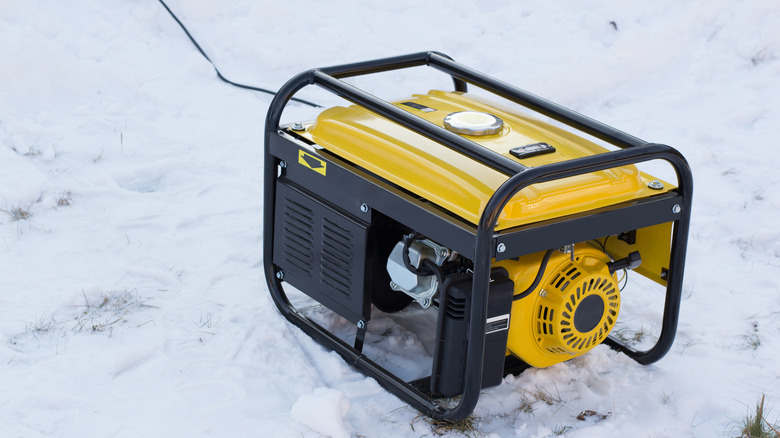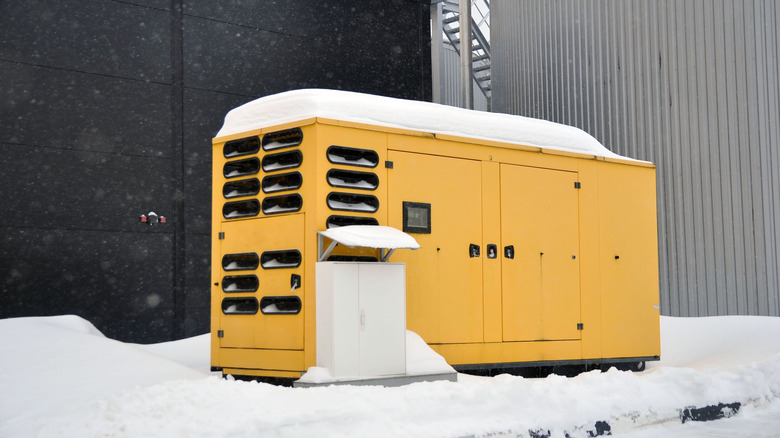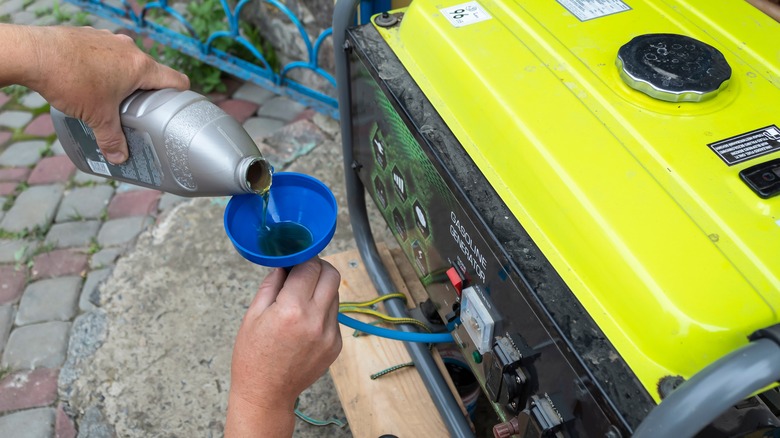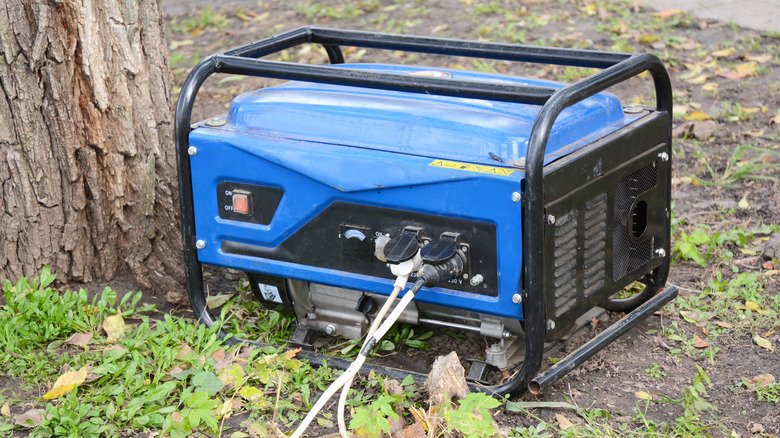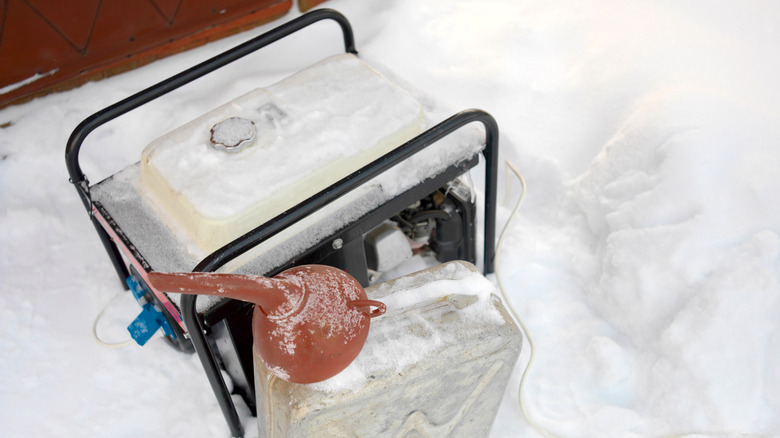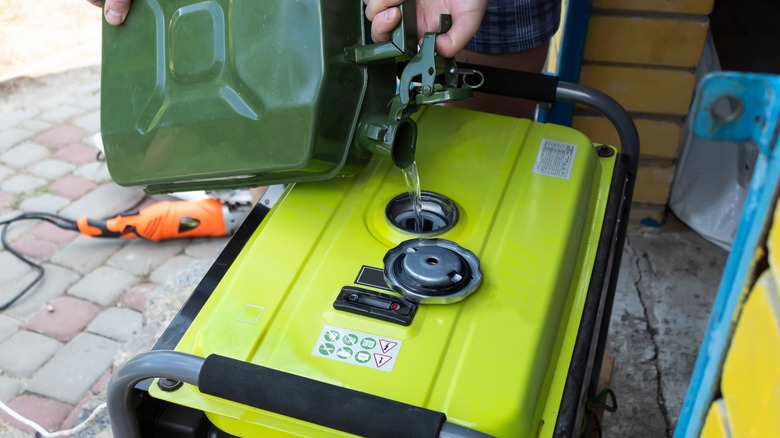5 Tips For Using Your Generator Safely In Winter
For the majority of Americans, winter comes with plenty of uncertainties. Winter is known to wreak havoc in many regions and the worry of power interruptions and outages is a reality that many homeowners have to live with. In a bid to prepare for the worst, some folks resort to purchasing generators to keep the power up and running, just in case the winter gets worse than expected. Generators can be a lifesaver when power outages happen unannounced — think about losing all your heating sources in the frigid winter temperatures, your house will quickly become uninhabitable!
While having a backup generator is a good idea for most homes, you need to realize that they come with their fair share of risks as well. The Consumer Product Safety Commission mentions that the major hazard associated with generator use is carbon monoxide poisoning. In fact, carbon monoxide poisoning from generator use can quickly turn fatal when used in closed environments. The good news is that with a few safety precautions, you can adequately prepare your home for power outages. Here are a few tips for using your generator safely during this winter season.
Choose the placement carefully
As established, the biggest concern when using a generator is the risk associated with carbon monoxide poisoning. You should never underestimate just how much carbon monoxide is produced by a standard 5.5kW generator. The Centers for Disease Control mentions that such generators have the capacity of producing as much carbon monoxide as six idle vehicles. In order to stay safe from Carbon monoxide poisoning, it is imperative to carefully choose the location of your generator.
When you run a generator close to your home, carbon monoxide can easily find its way into your house, incapacitating the unfortunate inhabitants. Not even the garage is not a good place to run the generator — rather, consider placing the generator away from your house. Also, as a precautionary measure, it is a good idea to install carbon monoxide sensors in your home. Some smoke sensors are equipped with this function so you might need to check with your manufacturer if you already have one installed.
Change the oil
Ensuring your generator is in tip-top shape before winter is necessary especially if you are living in areas that are prone to harsh winters. While there are plenty of maintenance duties for a generator, changing the oil sits right at the top of the list. CRG Electric mentions that changing the oil goes a long way in improving the functionality of your generator, not to mention extending the life of your machine as well. However, how often you will need to change the oil for your generator will depend on factors like the specific model and also how long you have been using it. CT Generator Service recommends changing the oil after 100 hours of service.
When changing the generator oil, be sure that you top up with enough oil. To protect the engine, generators are known to shut down if the oil level is too low — it will be a shame if your generator shuts down during a power outage which is when you need it the most. To stay ready for the unpredictable winter, it is necessary to make sure that your generator is working properly. By changing the oil, you can rest assured that it will be of use when the time of need arrives.
Consider installing a transfer switch
In order to safely use your generator during a power outage, you will need a way to transfer the power from your generator into your home. While you can achieve this by running numerous cords from the generator into the house, an easier alternative that will not only save you time, but also eliminate the risks associated with back feeding the power into the house, is installing a transfer switch. Essentially, a transfer switch makes sure that the connection between your utility power and the generator power doesn't share household circuits simultaneously.
It separates the generator from the utility power to safeguard the generator in the event of a power outage. According to Consumer Reports, the transfer switch needs to be installed by an electrician and will cost you between $500 and $1,500. Because you never know when there will be a power outage, preparing beforehand is advised. Remember, finding a professional who is willing to come and install the switch during a blizzard can be hard.
Allow the generator to cool before refilling
Apart from carbon monoxide poisoning, another risk that is associated with using a generator is igniting fuel. Most generators have their fuel tanks right at the top for convenience purposes. This positioning not only makes it easy to refuel whenever necessary but also allows the fuel to get to the carburetor via gravity. If you are not careful, this convenient setup can quickly turn tragic if you decide to refuel a hot generator. After a lengthy operation, a generator's engine will be very hot. A hot engine can ignite any spilled gas, and since you are handling more in the container in your hands, you can already see how such a scenario can quickly turn fatal.
The Consumer Product Safety Commission cautions against any attempt to refuel a hot generator. The best course of action is to turn the generator off and wait until the engine is completely cooled before refilling. Also, avoid storing your generator close to combustible objects, and be sure to store any remaining gas in a well-labeled container and place it away from the hot generator. It only takes something small to start an inferno that will raze down an entire building.
Use the right fuel
Having the right fuel on standby is necessary just in case you need it. However, it is worth mentioning that stocking up on the wrong fuel is a recipe for disaster. While there are several types of fuel, for instance, diesel and gasoline, the right one for your generator is the one recommended by the respective manufacturer. Something else that is important to note is that using stale fuel is a quick way of killing your generator engine. According to Road & Track fuel goes bad after thirty days unless stored in an airtight container to prevent interaction with air.
Unfortunately, the generator system is not airtight, so it is necessary for you to add fuel stabilizers to the gas in order to prevent the formation of sticky resins that will quickly ruin your carburetor. This is particularly important when prepping your generator for unknown eventualities that would happen after unspecified periods. The lifespan of stabilizers varies according to the manufacturer, however, most brands should protect the fuel for up to a year.
